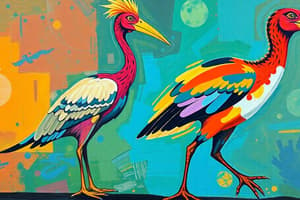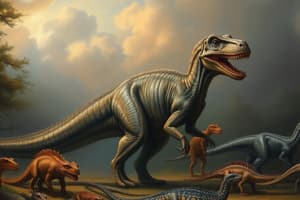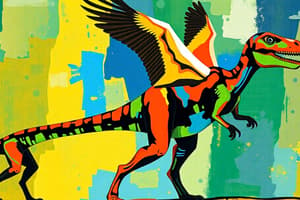Podcast
Questions and Answers
Which factor does NOT significantly influence our understanding of clade evolution?
Which factor does NOT significantly influence our understanding of clade evolution?
- The quality of the fossil record
- The number of species alive today
- The types of eggs laid by related species. (correct)
- The branching nature of evolution
Why is Archaeopteryx considered a pivotal fossil in understanding avian evolution?
Why is Archaeopteryx considered a pivotal fossil in understanding avian evolution?
- It laid eggs like modern birds
- It was found in multiple locations, thus linking disparate ecosystems.
- It combines avian and theropod characteristics. (correct)
- It had fully developed wings, indicating advanced flight capabilities.
What is the significance of the Jehol biota in understanding the evolution of both birds and theropods?
What is the significance of the Jehol biota in understanding the evolution of both birds and theropods?
- The volcanic eruptions fossilized dinosaur footprints.
- The sediment was ideal for preserving dinosaur eggs.
- The ashes allowed for easy excavation of fossils.
- The rapid burial of carcasses allowed for exceptional preservation. (correct)
How has the understanding of theropod evolution changed in recent years?
How has the understanding of theropod evolution changed in recent years?
Why is a combination of 'ground up' and 'trees down' considered to be the most likely explanation for the evolution of flight in theropods?
Why is a combination of 'ground up' and 'trees down' considered to be the most likely explanation for the evolution of flight in theropods?
What is the likely reason the Gatornithiformes went extinct?
What is the likely reason the Gatornithiformes went extinct?
What led to the shift in how dinosaurs were depicted, from sprawling to upright postures?
What led to the shift in how dinosaurs were depicted, from sprawling to upright postures?
How did ossified tendons influence the movement and posture of some dinosaurs?
How did ossified tendons influence the movement and posture of some dinosaurs?
What does the narrow gauge found in dinosaur trackways suggest about their posture?
What does the narrow gauge found in dinosaur trackways suggest about their posture?
How do hip and shoulder heights relate to neck posture in sauropods?
How do hip and shoulder heights relate to neck posture in sauropods?
What is the most accurate way to describe whether dinosaurs were warm or cold blooded?
What is the most accurate way to describe whether dinosaurs were warm or cold blooded?
What evidence suggests that some dinosaurs may have been endothermic?
What evidence suggests that some dinosaurs may have been endothermic?
How do dinosaur fossils at high latitudes contribute to our understanding of their thermoregulation?
How do dinosaur fossils at high latitudes contribute to our understanding of their thermoregulation?
What can be inferred from the range of eggshell types found among dinosaurs?
What can be inferred from the range of eggshell types found among dinosaurs?
What can dinosaur teeth best tell us?
What can dinosaur teeth best tell us?
What is the significance of the coronoid process in understanding dinosaur diets?
What is the significance of the coronoid process in understanding dinosaur diets?
Why are sauropod teeth interpreted as being adapted for browsing and branch stripping rather than chewing?
Why are sauropod teeth interpreted as being adapted for browsing and branch stripping rather than chewing?
How can CAT scans of dinosaur skulls inform us about their behavior?
How can CAT scans of dinosaur skulls inform us about their behavior?
What is the most likely reason that sauropods were able to grow so large?
What is the most likely reason that sauropods were able to grow so large?
How did the macronarian and diplodocid sauropods differ in their feeding strategies, based on their anatomy?
How did the macronarian and diplodocid sauropods differ in their feeding strategies, based on their anatomy?
Flashcards
What is evolution?
What is evolution?
Process where ancestor gives rise to descendant species; features are added, lost, or modified incrementally.
Who is Archaeopteryx?
Who is Archaeopteryx?
The oldest known bird from the Late Jurassic period.
What is Jehol biota?
What is Jehol biota?
A location in northeast China with extraordinary fossil bird preservation.
Are birds theropods?
Are birds theropods?
Signup and view all the flashcards
Theories of flight?
Theories of flight?
Signup and view all the flashcards
What is a sprawling posture?
What is a sprawling posture?
Signup and view all the flashcards
What is an upright posture?
What is an upright posture?
Signup and view all the flashcards
Ostrom's Deinonychus?
Ostrom's Deinonychus?
Signup and view all the flashcards
What are ossified tendons?
What are ossified tendons?
Signup and view all the flashcards
Did dinosaurs drag tails?
Did dinosaurs drag tails?
Signup and view all the flashcards
Dinosaur trackways?
Dinosaur trackways?
Signup and view all the flashcards
What are endotherms?
What are endotherms?
Signup and view all the flashcards
What are ectotherms?
What are ectotherms?
Signup and view all the flashcards
What is homeotherms?
What is homeotherms?
Signup and view all the flashcards
What is poikilotherms?
What is poikilotherms?
Signup and view all the flashcards
Feathers in dinosaurs?
Feathers in dinosaurs?
Signup and view all the flashcards
Calcium carbonate in egg shells?
Calcium carbonate in egg shells?
Signup and view all the flashcards
Ceratopsians & ornithopods (iguanodonts)
Ceratopsians & ornithopods (iguanodonts)
Signup and view all the flashcards
Sauropod teeth?
Sauropod teeth?
Signup and view all the flashcards
Dinosaur behavior?
Dinosaur behavior?
Signup and view all the flashcards
Study Notes
Dinosaurs are Birds
- Evolution is a branching process, with features added, lost, or modified incrementally.
- Most species go extinct, limiting our understanding of evolutionary history to surviving and fossilized species.
- Archaeopteryx exhibits bird-like flight capabilities yet retains theropod features like a long bony tail and hand claws.
- Bird bones are fragile and often poorly preserved.
- The Jehol biota preserves feathered non-avian theropods as well as birds.
- Birds are theropods belonging to the maniraptoran group, closely related to anchiornithids, troodontids, and dromaeosaurs.
- Flight evolution likely involved a combination of ground-up running and tree-down gliding.
- Birds experienced a significant evolutionary radiation after the Cretaceous extinction.
- During the Cenozoic Era, the now-extinct Gatornithiformes and phorusrhacids likely were predatory birds.
Posture
- Sprawling posture is observed in crocodilians, lizards, tuataras, and amphibians.
- Mammals and birds have a vertically aligned limbs.
- Early dinosaur depictions wrongly showed sprawling postures.
- Early dinosaur reconstructions incorrectly showed dragging tails.
- Some early illustrations were anatomically unsound.
- The dinosaur renaissance began with John Ostrom's study of Deinonychus, highlighting its active, upright posture supported by a slender build, ossified tail tendons, and a sickle claw.
- Ossified tendons stiffened the tails of some ornithopods and ankylosaurs.
- Sauropods, theropods, and stegosaurs lacked ossified tendons, allowing greater tail movement.
- Trackways indicate dinosaurs generally held their tails horizontally without dragging them.
- Most dinosaur trackways suggest an upright posture.
- Sauropods like Diplodocus had tall hips and held their necks horizontally, while Brachiosaurus had taller shoulders than hips and held their necks upright.
Cold-blooded or Warm?
- Overlap issues make "warm-blooded" and "cold-blooded" terms confusing.
- Endotherms internally regulate temperature; ectotherms rely on external heat.
- Poikilotherms' body temperatures vary, while homeotherms' stay relatively constant.
- Modern endotherms: mammals and birds and modern ectotherms: reptiles, amphibians, fish, and invertebrates.
- Endothermy enables sustained activity but requires significantly more energy than ectothermy.
- Dinosaurs were initially assumed to be ectotherms.
- Ostrom's Deinonychus discovery prompted reconsideration of dinosaur metabolism toward endothermy.
- Upright postures support higher energy levels associated with endothermy, especially in bipeds.
- Trackways indicate slower paces, which is expected as animals don't often move at top speed.
- Insulating feathers in dinosaurs and similar structures in pterosaurs suggests heat conservation adaptations.
- Predator-prey ratios suggest many prey animals for fewer predators which suggests endothermy.
- Dinosaurs were found in high latitudes suggesting warmer poles, since ectothermic crocodilians and lizards were also present.
- Bone microstructure, nasal turbinates, lungs and heart anatomy, and bone chemistry have been used to determine whether dinosaurs were endotherms, with limited and conflicting results.
- It is believed some dinosaurs were likely endothermic homeotherms or gigantothermic homeotherms.
Parenting
- Reptilian and avian eggshells have calcium carbonate to prevent drying out.
- Birds’ and crocodilians’ eggs are hard due to a thick layer, but turtles and squamates have soft, leathery eggs.
- Squamates and turtles provide minimal parental care, while crocodilians offer some protection. Birds give extensive care to their young.
- Eggs are difficult to fossilize as they are hollow and thin-shelled.
- Dromaeosaur theropod eggs were found to be blue.
- Dinosaur eggs were typically laid in shallow excavations.
- Oviraptors have been found preserved on top of nests which suggest parental care.
- Adult and juvenile skeletons found together show parental care.
- CAT scans are hard to interpret because there is little difference in density between and eggshell and surrounding rock.
- Raman microscopy and microscopic examination of dinosaur eggshells reveal that some were highly calcified, like birds and crocodilians, while others were leathery, like turtles and lizards.
- Pterosaurs likely had leathery, soft eggshells, too.
- Hard eggshells evolved multiple times within dinosaurs and parental care varied.
What to Feed a Dinosaur
- Tooth shape and function in modern animals provide evidence for dinosaur diets.
- The coronoid process of the jaw is used to determine the ability to chew.
- Many dinosaurs were herbivorous, including stegosaurs, ankylosaurs, pachycephalosaurs, ornithopods, ceratopsians, and sauropods.
- Stegosaurs, ankylosaurs, pachycephalosaurs, and early ornithopods had flattened, serrated teeth, suggesting little chewing.
- Ceratopsians and advanced ornithopods had dental batteries for shearing and grinding, continually shedding and regrowing teeth.
- Sauropods had odd, peg-shaped teeth, adapted for browsing and branch stripping.
- Plant-eating dinosaurs used fermentation to digest food. Stegosaurs, ankylosaurs, pachycephalosaurs, ceratopsians, hadrosaurs, and sauropods did this.
- Many herbivorous dinosaurs had a keratin beak.
- Ornithomimids, oviraptors and birds are theropods containing keratin beaks.
- Theropod teeth varied based on prey.
- Dromaeosaurs and troodontids had narrow serrated teeth.
- Tyrannosaurids had serrated bulky teeth for crushing through bone, while spinosaurs had conical teeth for seizing fish.
- Toothlessness and keratin beaks evolved separately three times in ornithomimids, oviraptors, and birds.
Behavior
- Dinosaur behavior is inferred from anatomy/modern animals.
- CAT scans estimate brain lobe sizes (eyesight, smell, hearing) and head orientation.
- CAT scans show T. rex had binocular vision, rapid eye movement, a strong sense of smell, and good hearing.
- Hadrosaur crests likely made low trumpeting sounds, for species identification, display, and mating.
- Horns and frills of ceratopsians likely served same purpose.
- Organisms can have multiple functions.
- Ceratopsian horn and frill variation comes from species differences and variation within.
- Mass burials suggest herding by hadrosaurs, ceratopsians and Sauropods.
- How sex worked in dinosaurs is unknown.
- A Psittacosaurus specimen preserves a cloaca.
- How it likely worked can be inferred from birds/crocodilians.
- Face biting occurred with theropods which indicates mating behaviors.
- Fossilized behaviors include dinosaurs fighting, dinosaurs sitting on nests.
- Fossils need killed/buried quickly to stay locked.
- The meaning behvaioral fossils may be unique.
Life as Giants
- Sauropods were the largest land animals, but the blue whale is larger.
- Gigantic size evolved independently 36+ times, approaching land animal limit.
- It is unknown why large size was selected for in sauropods.
- Sauropods' size made burial limited, and most are known from few bones.
- Body mass estimated from scale models/limb size relationships.
- Sauropods had different food digestion forms.
- Digestion primarily took place as hind-gut fermentation.
- Sauropods had two primary forms
- Macronarians -- tall necks/shoulders -- browsed in trees -- spatula-shaped teeth -- tall skulls
- Diplodocids -- Flattened skulls -- Pencil-shaped teeth -- browsed along the ground -- tall hips
- Tooth wear patterns support browsing (diplodocids teeth had fine wear, but macronarian teeth had coarse wear).
- Nutritious Mesozoic foods= horsetails, Araucaria, ginkgos, tree ferns
- Poor foods= most ferns, podocarp conifers like cypress/redwood, cycads
- Weight Adaptations of sauropods: pillar-shaped legs, dense bones, simple joints, and small head.
- Sauropods likely had 4-chambered hearts and giraffe-like blood pressure adaptations.
- Sauropods had continuous airflow breathing.
- There are complex set of features that enabled Sauropods to become giants.
- Their ancestral traits: Clutch of eggs + lack of food chewing
- Derived traits: fast growth, respiration + slower metabolism rate.
Studying That Suits You
Use AI to generate personalized quizzes and flashcards to suit your learning preferences.




